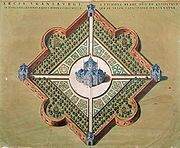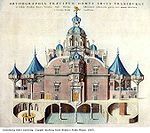
Uraniborg
Encyclopedia


Denmark
Denmark is a Scandinavian country in Northern Europe. The countries of Denmark and Greenland, as well as the Faroe Islands, constitute the Kingdom of Denmark . It is the southernmost of the Nordic countries, southwest of Sweden and south of Norway, and bordered to the south by Germany. Denmark...
astronomical observatory
Observatory
An observatory is a location used for observing terrestrial or celestial events. Astronomy, climatology/meteorology, geology, oceanography and volcanology are examples of disciplines for which observatories have been constructed...
operated by Tycho Brahe
Tycho Brahe
Tycho Brahe , born Tyge Ottesen Brahe, was a Danish nobleman known for his accurate and comprehensive astronomical and planetary observations...
; built circa 1576-1580 on Hven
Hven
Ven is a small Swedish island in the Öresund strait, between Scania and Zealand . It is situated in Landskrona Municipality, Skåne County. The island has 371 inhabitants and an area of . During the 1930s, the population was at its peak, with approximately 1,300 inhabitants...
, an island in the Øresund
Oresund
The Sound , is the strait that separates the Danish island Zealand from the southern Swedish province of Scania. Its width is just at the narrowest point between Helsingør, Denmark, and Helsingborg, Sweden...
between Zealand and Scania
Scania
Scania is the southernmost of the 25 traditional non-administrative provinces of Sweden, constituting a peninsula on the southern tip of the Scandinavian peninsula, and some adjacent islands. The modern administrative subdivision Skåne County is almost, but not totally, congruent with the...
, which at that time was part of Denmark. The observatory was shortly after its construction expanded with an underground facility, Stjerneborg
Stjerneborg
Stjerneborg was Tycho Brahe's underground observatory next to his palace-observatory Uraniborg, located on the island of Hven in Oresund....
, on an adjacent site. Uraniborg was demolished in 1601, shortly after Brahe fell out of favour with the Danish king and left the country, and Hven was later lost to Sweden
Sweden
Sweden , officially the Kingdom of Sweden , is a Nordic country on the Scandinavian Peninsula in Northern Europe. Sweden borders with Norway and Finland and is connected to Denmark by a bridge-tunnel across the Öresund....
. The Round Tower
Rundetårn
The Rundetårn is a 17th-century tower located in central Copenhagen, Denmark. One of the many architectural projects of Christian IV, it was built as an astronomical observatory...
in Copenhagen
Copenhagen
Copenhagen is the capital and largest city of Denmark, with an urban population of 1,199,224 and a metropolitan population of 1,930,260 . With the completion of the transnational Øresund Bridge in 2000, Copenhagen has become the centre of the increasingly integrating Øresund Region...
was inaugurated in 1642 as a replacement.
History
The building was dedicated to UraniaUrania
Urania was, in Greek mythology, the muse of astronomy. Some accounts list her as the mother of the musician Linus. She is usually depicted with a globe in her left hand. She is able to foretell the future by the arrangement of the stars...
, the Muse of Astronomy and named Uranienborg, "The Castle of Urania." It was the first custom-built observatory, and the last to be built without a telescope
Telescope
A telescope is an instrument that aids in the observation of remote objects by collecting electromagnetic radiation . The first known practical telescopes were invented in the Netherlands at the beginning of the 1600s , using glass lenses...
as its primary instrument. The cornerstone
Cornerstone
The cornerstone concept is derived from the first stone set in the construction of a masonry foundation, important since all other stones will be set in reference to this stone, thus determining the position of the entire structure.Over time a cornerstone became a ceremonial masonry stone, or...
was laid on August 8, 1576. Tycho abandoned Uranienborg in 1597, and it was destroyed in 1601. The grounds are currently being restored.
The main building of Uraniborg was square, about 15 meters on a side, and built mostly of red brick. Two semi-circular towers, one each on the north and south sides of the main building, giving the building a somewhat rectangular shape overall. The main floor consisted of four rooms, one of which was occupied by Tycho and his family, the other three for visiting astronomers. The northern tower housed the kitchens, and the southern a library. The second floor was divided into three rooms, two of equal size and one larger. The larger room was reserved for visiting royalty. On this level the towers housed the primary astronomical instruments, accessed from outside the building or from doors on this floor. Outrider towers, supported on pillars, housed additional instruments slightly further from the building, giving them a wider angle of view. On the third floor was a "loft", subdivided into eight smaller rooms for students. Only the roofs of the towers reached this level, although a single additional tower extended above the loft in the middle of the building, similar to a widow's walk
Widow's walk
A widow's walk also known as a "widow's watch" is a railed rooftop platform often with a small enclosed cupola frequently found on 19th century North American houses. A popular romantic myth holds that the platform was used to observe vessels at sea...
, accessed via a spiral staircase from the 3rd floor. Uraniborg also featured a large basement; it housed an alchemical laboratory in one end, and storage for food, salt and fuel at the other.
A large wall, 75 meters on a side and 5.5 meters high was planned to surround Uraniborg, but never built, instead a high earth mound was constructed and lasted until today being the only remnant of the observatory still in place. Uraniborg was located in the very middle, with an extensive set of intricate gardens between the mound walls and the building. In addition to being decorative, the gardens also supplied herbs for the Tycho's medicinal chemistry experiments. The gardens are currently being re-created, using seeds found on-site or identified in Tycho's writings.
Uraniborg was an extremely expensive project. It is estimated that it cost about 1% of the entire state budget during construction,.
Shortly after construction it became clear that the tower-mounted instruments were too easily moved by wind, and Tycho set about constructing a more suitable observation site. The result was Stjerneborg
Stjerneborg
Stjerneborg was Tycho Brahe's underground observatory next to his palace-observatory Uraniborg, located on the island of Hven in Oresund....
("castle of the stars"), a smaller site built entirely at ground level and dedicated purely to observations (there was no "house"). The basic layout was similar to Uraniborg, with a wall of similar shape surrounding the site, although the enclosed area was much smaller. The instruments were all placed underground, covered by opening shutters or a rotating dome in buildings built over the instrument pits.
Upon losing financial support from the new king, Christian IV of Denmark
Christian IV of Denmark
Christian IV was the king of Denmark-Norway from 1588 until his death. With a reign of more than 59 years, he is the longest-reigning monarch of Denmark, and he is frequently remembered as one of the most popular, ambitious and proactive Danish kings, having initiated many reforms and projects...
, Tycho abandoned Hven in 1597 and both Uraniborg and Stjerneborg were destroyed shortly after Tycho's death. Stjerneborg was the subject of archaeological excavations during the 1950s, resulting in the restoration of the observatory. Stjerneborg now houses a multimedia show.

